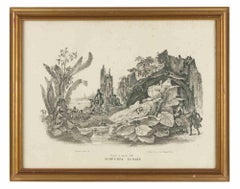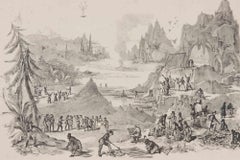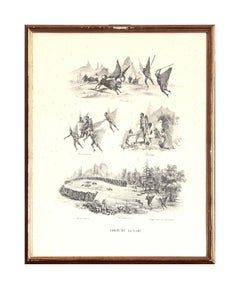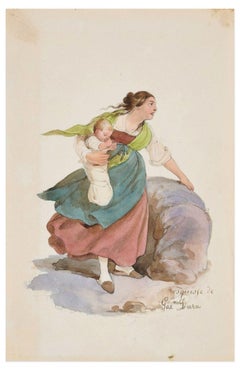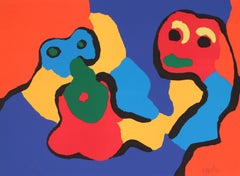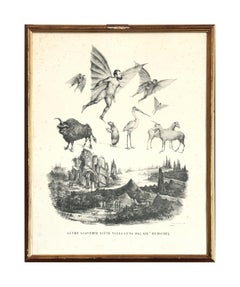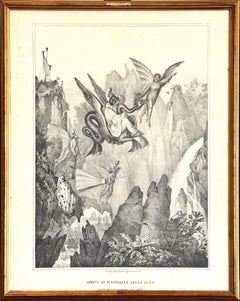Gaetano Dura Art
1805-1878
Gaetano Dura was born on August 7, 1805, in Cassano allo Ionio, Italy. He was a very famous Italian lithographer, watercolor artist and a poet. He died on June 4, 1878, in Naples, Italy.
to
2
4
2
2
2
1
3
Overall Height
to
Overall Width
to
2
2
4
1
1
1
1
1
2
2
4
6,886
3,209
2,514
1,217
3
1
1
1
Artist: Gaetano Dura
Lunar Discovery - Lithograph by Gaetano Dura -- 1836
By Gaetano Dura
Located in Roma, IT
Lunar discovery is a lithograph made by Gaetano Dura.
Title on the lower center. Published by Lithography Fergola, Naples (printed on lower center). On lower right is printed: Museo...
Category
1830s Modern Gaetano Dura Art
Materials
Lithograph
Permanence in the Moon - Lithograph by Gaetano Dura -- 1836
By Gaetano Dura
Located in Roma, IT
Permanence in the Moon is a lithograph made by Gaetano Dura.
Title on the lower center. Published by Lithography Fergola, Naples (printed on lower center). On lower right is printe...
Category
Early 20th Century Modern Gaetano Dura Art
Materials
Lithograph
Lunar Costumes - 20th Century - Gaetano Dura - Lithograph - Old Masters
By Gaetano Dura
Located in Roma, IT
Lunar Costumes is an original lithograph by Gaetano Dura.
Titled on the lower center. Signed printed on lower left. Published by Lithography Gatti e Dura, Naples (printed on lower r...
Category
20th Century Old Masters Gaetano Dura Art
Materials
Lithograph
Woman - Original Ink Drawing and Watercolor by G. Dura - 19th Century
By Gaetano Dura
Located in Roma, IT
Woman is an original watercolor artwork realized in the XIX century by Gaetano Dura.
Good conditions except for yellowing of the paper, some folds on the higher and right margin, a...
Category
19th Century Old Masters Gaetano Dura Art
Materials
Ink, Watercolor
Related Items
Some People Together
By Karel Appel
Located in New York, NY
Some People Together, 1974
Hand-signed and dated in pencil
Color lithograph and screenprint
Sheet 22 x 29 3/4 inches; 559 x 756 mm.
Edition 110
Category
1970s Modern Gaetano Dura Art
Materials
Lithograph, Screen
The Abduction of the Sabine Women , a Renaissance drawing by Biagio Pupini
Located in PARIS, FR
This vigorous drawing has long been attributed to Polidoro da Caravaggio: The Abduction of the Sabine Women is one of the scenes that Polidoro depicted between 1525 and 1527 on the façade of the Milesi Palazzo in Rome. However, the proximity to another drawing inspired by this same façade, kept at the Ecole des Beaux-Arts, and to other drawings inspired by Polidoro kept at the Musée du Louvre, leads us to propose an attribution to Biagio Pupini, a Bolognese artist whose life remains barely known, despite the abundant number of drawings attributed to him.
1. Biagio Pupini, a Bolognese artist in the light of the Roman Renaissance
The early life of Biagio Pupini, an important figure of the first half of the Cinquecento in Bologna - Vasari mentions him several times - is still poorly known. Neither his date of birth (probably around 1490-1495) nor his training are known. He is said to have been a pupil of Francesco Francia (1450 - 1517) and his name appears for the first time in 1511 in a contract with the painter Bagnacavallo (c. 1484 - 1542) for the frescoes of a church in Faenza. He then collaborated with Girolamo da Carpi, at San Michele in Bosco and at the villa of Belriguardo.
He must have gone to Rome for the first time with Bagnacavallo between 1511 and 1519. There he discovered the art of Raphael, with whom he might have worked, and that of Polidoro da Caravaggio. This first visit, and those that followed, were the occasion for an intense study of ancient and modern art, as illustrated by his abundant graphic production.
Polidoro da Caravaggio had a particular influence on the technique adopted by Pupini. Executed on coloured paper, his drawings generally combine pen, brown ink and wash with abundant highlights of white gouache, as in the drawing presented here.
2. The Abduction of the Sabine Women
Our drawing is an adaptation of a fresco painted between 1525 and 1527 by Polidoro da Caravaggio on the façade of the Milesi Palace in Rome. These painted façades were very famous from the moment they were painted and inspired many artists during their stay in Rome. These frescoes are now very deteriorated and difficult to see, as the palace is in a rather narrow street.
The episode of the abduction of the Sabine women (which appears in the centre of the photo above) is a historical theme that goes back to the origins of Rome and is recounted both by Titus Livius (Ab Urbe condita I,13), by Ovid (Fasti III, 199-228) and by Plutarch (II, Romulus 14-19). After killing his twin brother Romus, Romulus populates the city of Rome by opening it up to refugees and brigands and finds himself with an excess of men. Because of their reputation, none of the inhabitants of the neighbouring cities want to give them their daughters in marriage. The Romans then decide to invite their Sabine neighbours to a great feast during which they slaughter the Sabines and kidnap their daughters.
The engraving made by Giovanni Battista Gallestruzzi (1618 - 1677) around 1656-1658 gives us a good understanding of the Polidoro fresco, allowing us to see how Biagio Pupini reworked the scene to extract this dynamic group.
With a remarkable economy of means, Biagio Pupini takes over the left-hand side of the fresco and depicts in a very dense space two main groups, each consisting of a Roman and a Sabine, completed by a group of three soldiers in the background (which seems to differ quite significantly from Polidoro's composition).
The balance of the drawing is based on a very strongly structured composition. The drawing is organised around a median vertical axis, which runs along both the elbow of the kidnapped Sabine on the left and the foot of her captor, and the two main diagonals, reinforced by four secondary diagonals. This diamond-shaped structure creates an extremely dynamic space, in which centripetal movements (the legs of the Sabine on the right, the arm of the soldier on the back at the top right) and centrifugal movements (the arm of the kidnapper on the left and the legs of the Sabine he is carrying away, the arm of the Sabine on the right) oppose each other, giving the drawing the appearance of a whirlpool around a central point of support situated slightly to the left of the navel of the kidnapper on the right.
3. Polidoro da Caravaggio, and the decorations of Roman palaces
Polidoro da Caravaggio was a paradoxical artist who entered Raphael's (1483 - 1520) workshop at a very young age, when he oversaw the Lodges in the Vatican. Most of his Roman work, which was the peak of his career, has disappeared, as he specialised in facade painting, and yet these paintings, which are eminently visible in urban spaces, have influenced generations of artists who copied them abundantly during their visits to Rome.
Polidoro Caldara was born in Caravaggio around 1495-1500 (the birthplace of Michelangelo Merisi, known as Caravaggio, who was born there in 1571), some forty kilometres east of Milan. According to Vasari, he arrived as a mason on the Vatican's construction site and joined Raphael's workshop around 1517 (at the age of eighteen according to Vasari). This integration would have allowed Polidoro to work not only on the frescoes of the Lodges, but also on some of the frescoes of the Chambers, as well as on the flat of Cardinal Bibiena in the Vatican.
After Raphael's death in 1520, Polidoro worked first with Perin del Vaga before joining forces with Maturino of Florence (1490 - 1528), whom he had also known in Raphael's workshop. Together they specialised in the painting of palace façades. They were to produce some forty façades decorated with grisaille paintings imitating antique bas-reliefs.
The Sack of Rome in 1527, during which his friend Maturino was killed, led Polidoro to flee first to Naples (where he had already stayed in 1523), then to Messina. It was while he was preparing his return to the peninsula that he was murdered by one of his assistants, Tonno Calabrese, in 1543.
In his Vite, Vasari celebrated Polidoro as the greatest façade decorator of his time, noting that "there is no flat, palace, garden or villa in Rome that does not contain a work by Polidoro". Polidoro's facade decorations, most of which have disappeared as they were displayed in the open air, constitute the most important lost chapter of Roman art of the Cinquecento. The few surviving drawings of the painter can, however, give an idea of the original appearance of his murals and show that he was an artist of remarkable and highly original genius.
4. The façade of the Milesi Palace
Giovanni Antonio Milesi, who commissioned this palace, located not far from the Tiber, north of Piazza Navona, was a native of the Bergamo area, like Polidoro, with whom he maintained close friendly ties. Executed in the last years before the Sack of Rome, around 1526-1527, the decoration of Palazzo Milesi is considered Polidoro's greatest decorative success.
An engraving by Ernesto Maccari made at the end of the nineteenth century allows us to understand the general balance of this façade, which was still well preserved at the time. The frescoes were not entirely monochrome, but alternated elements in chiaroscuro simulating marble bas-reliefs and those in ochre simulating bronze and gold vases...
Category
16th Century Old Masters Gaetano Dura Art
Materials
Ink, Gouache, Pen
Fine 1700's Italian Old Master Ink & Wash Drawing Roman Allegorical Insubria
Located in Cirencester, Gloucestershire
'Insubria'
Italian School, 18th century
ink and wash drawing on paper, framed within a light oak wood frame (behind glass)
image size: 10.5 x 7 inches
overall framed: 17 x 13 inches
...
Category
18th Century Old Masters Gaetano Dura Art
Materials
Watercolor, Ink, Archival Paper
Follower of Francesco Guardi, Figures in a Mediterranean port by a Roman Arch
By Francesco Guardi
Located in Harkstead, GB
A lively, well executed sketch painted by a 19th century follower of Francesco Guardi
Follower of Francesco Guardi, 19th Century
Figures by a Roman Arch
Watercolour with ink and sc...
Category
19th Century Old Masters Gaetano Dura Art
Materials
Paper, Ink, Watercolor
Free Shipping
H 6.5 in W 5 in D 1 in
Some People Together
By Karel Appel
Located in New York, NY
Some People Together, 1974
Hand-signed and dated in pencil
Color lithograph and screenprint
Sheet 22 x 29 3/4 inches; 559 x 756 mm.
Edition 110
Category
1970s Modern Gaetano Dura Art
Materials
Lithograph, Screen
Don Quixote dans la Bibliotèque II by Bernard Buffet - signed color lithograph
By Bernard Buffet
Located in New York, NY
This is a signed color lithograph by Bernard Buffet from the Don Quixote series printed in 1989 at the Atelier Mourlot, Paris. This particular image is of Don Quixote in his library....
Category
Late 20th Century Modern Gaetano Dura Art
Materials
Lithograph
Baldassarre Franceschini, Sleeping Cupid, Valentine's Day Gift
Located in Harkstead, GB
A beautiful 19th century copy by Giuseppe Rocchi of Baldassarre Franceschini's Sleeping Cupid, presented in a very attractive gilt frame with hand carved mouldings. A very peaceful i...
Category
Mid-19th Century Old Masters Gaetano Dura Art
Materials
Paper, Watercolor
Fine 1700's Italian Old Master Ink & Wash Drawing Roman Allegorical Figure Fame
Located in Cirencester, Gloucestershire
'Fame'
Italian School, 18th century
ink and wash drawing on paper, framed within a light oak wood frame (behind glass)
image size: 10.5 x 7 inches
overall framed: 17 x 13 inches
cond...
Category
18th Century Old Masters Gaetano Dura Art
Materials
Watercolor, Ink, Archival Paper
Fine 1700's Italian Old Master Ink & Wash Drawing Roman Allegorical Providenza
Located in Cirencester, Gloucestershire
'Providenza'
Italian School, 18th century
ink and wash drawing on paper, framed within a light oak wood frame (behind glass)
image size: 10.5 x 7 inches
overall framed: 17 x 13 inche...
Category
18th Century Old Masters Gaetano Dura Art
Materials
Watercolor, Ink, Archival Paper
Giovanni Piranesi Etching of Ancient Roman Architecture, 18th Century
By Giovanni Battista Piranesi
Located in Alamo, CA
"Veduta del Sepolcro della Famiglia Plauzia per la Strada Che Conduce da Roma a Tivoli vicino a Ponte Lugano" from "Le Antichità Romane" (Roman Antiquities), one of the most famous works by Piranesi. "Antichita" illustrates the tombs along the Appian Way...
Category
Early 18th Century Old Masters Gaetano Dura Art
Materials
Etching, Engraving, Drypoint
H 24.38 in W 31.75 in D 0.75 in
Fine 1700's Italian Old Master Ink & Wash Drawing Roman Allegorical Sicilia
Located in Cirencester, Gloucestershire
'Sicilia'
Italian School, 18th century
ink and wash drawing on paper, framed within a light oak wood frame (behind glass)
image size: 10.5 x 7 inches
overall framed: 17 x 13 inches
c...
Category
18th Century Old Masters Gaetano Dura Art
Materials
Watercolor, Ink, Archival Paper
Fine 1700's Italian Old Master Ink & Wash Drawing Roman Female Statue of Beauty
Located in Cirencester, Gloucestershire
Belleza (The Art of Beauty)
Italian School, 18th century
ink and wash drawing on paper, framed within a light oak wood frame (behind glass)
image size: 10.5 x 7 inches
overall framed...
Category
18th Century Old Masters Gaetano Dura Art
Materials
Ink, Archival Paper, Watercolor
Previously Available Items
Discoveries On The Moon - 20th Century - Gaetano Dura - Lithograph - Old Masters
By Gaetano Dura
Located in Roma, IT
Discoveries On The Moon is an original lithograph made by Gaetano Dura.
Titled on the lower center. Published by Lithography Gatti e Dura, Naples (printed on lower left). XX century...
Category
20th Century Old Masters Gaetano Dura Art
Materials
Lithograph
H 21.26 in W 16.93 in D 0.99 in
Arrival Of Pulcinella - 20th Centuty - Gaetano Dura - Lithograph - Old Masters
By Gaetano Dura
Located in Roma, IT
Arrival Of Pulcinella On The Moon is an original lithograph made by Gaetano Dura.
Title on the lower center. Published by Lithography Fergola, Naples (printed on lower center). XX c...
Category
20th Century Old Masters Gaetano Dura Art
Materials
Lithograph
H 21.26 in W 16.93 in D 0.99 in
Discoveries Made On The Moon - 20th - Gaetano Dura - Lithograph - Old Masters
By Gaetano Dura
Located in Roma, IT
Discoveries Made On The Moon is an original lithograph realized by Gaetano Dura.
Titled on the lower center. Published by Lithography Fergola, Naples (printed on lower center). XX c...
Category
20th Century Old Masters Gaetano Dura Art
Materials
Lithograph
H 21.26 in W 16.93 in D 0.99 in
Returning Diligence - 20th Century - Gaetano Dura - Lithograph - Old Masters
By Gaetano Dura
Located in Roma, IT
Returning Diligence From The Moon is an original lithograph made by Gaetano Dura.
Titled on the lower center and signed printed on lower left. Published by Lithography Gatti e Dura,...
Category
20th Century Old Masters Gaetano Dura Art
Materials
Lithograph
H 21.26 in W 16.93 in D 0.99 in
Discoveries On The Moon - 1836 - Gaetano Dura - Lithograph - Old Masters
By Gaetano Dura
Located in Roma, IT
Discoveries On The Moon From "Great Astronomical Discoveries Lately Made By Sir John Herschel" is an original lithograph by Gaetano Dura. Title on lower center. Lithography Gatti e D...
Category
1830s Old Masters Gaetano Dura Art
Materials
Lithograph
H 21.26 in W 16.93 in D 0.99 in
Lunar Costumes - 1836 - Gaetano Dura - Lithograph - Old Masters
By Gaetano Dura
Located in Roma, IT
Lunar Costumes from "Great Astronomical Discoveries Lately Made by Sir John Herschel" is an original lithograph by Gaetano Dura. Signed on plate. Title on lower center. Lithography G...
Category
1830s Old Masters Gaetano Dura Art
Materials
Lithograph
H 21.26 in W 16.93 in D 0.99 in
Returning Diligence - 1836 - Gaetano Dura - Lithograph - Old Masters
By Gaetano Dura
Located in Roma, IT
Returning Diligence From The Moon From "Great Astronomical Discoveries Lately Made By Sir John Herschel" is an original lithograph by Gaetano Dura. Title on lower center. Lithography...
Category
1830s Old Masters Gaetano Dura Art
Materials
Lithograph
H 21.26 in W 16.93 in D 0.99 in
Discoveries Made On The Moon - 1836 - Gaetano Dura - Lithograph - Old Masters
By Gaetano Dura
Located in Roma, IT
Discoveries Made On The Moon From "Great Astronomical Discoveries Lately Made By Sir John Herschel" is an original lithograph by Gaetano Dura. Gilded wood frame included. Image dimen...
Category
1830s Old Masters Gaetano Dura Art
Materials
Lithograph
H 21.26 in W 16.93 in D 0.99 in
Arrival Of Pulcinella - 1836 - Gaetano Dura - Lithograph - Old Masters
By Gaetano Dura
Located in Roma, IT
Arrival Of Pulcinella On The Moon From "Great Astronomical Discoveries Lately Made By Sir John Herschel" is an original lithograph by Gaetano Dura. Title on lower center. Gilded wood...
Category
1830s Old Masters Gaetano Dura Art
Materials
Lithograph
H 21.26 in W 16.93 in D 0.99 in
Gaetano Dura art for sale on 1stDibs.
Find a wide variety of authentic Gaetano Dura art available for sale on 1stDibs. You can also browse by medium to find art by Gaetano Dura in lithograph, ink, paint and more. Much of the original work by this artist or collective was created during the 20th century and is mostly associated with the Old Masters style. Not every interior allows for large Gaetano Dura art, so small editions measuring 5 inches across are available. Customers who are interested in this artist might also find the work of Francesco Cecchini, Carle Vernet (Antoine Charles Horace Vernet), and James Seymour. Gaetano Dura art prices can differ depending upon medium, time period and other attributes. On 1stDibs, the price for these items starts at $134 and tops out at $579, while the average work can sell for $428.
Artists Similar to Gaetano Dura
Carle Vernet (Antoine Charles Horace Vernet)
Robert Sargent Austin, R.A., P.R.E., P.R.W.S.
